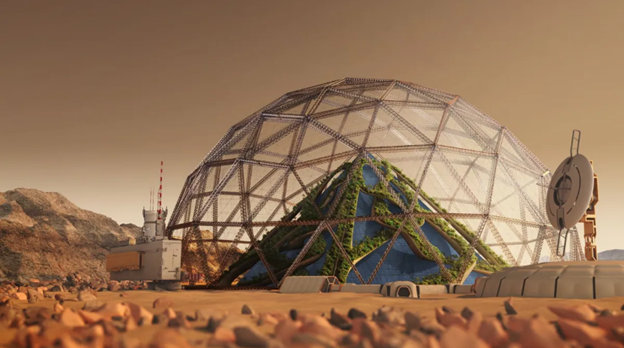by Rida Fatima

(Figure 1: 3D Illustration of a Mars outpost colony with a geodesic dome. Credit: https://interestingengineering.com/)
A report from the CNET network reveals that a detailed proposal has been made by a botanist and an ecologist for a flourishing green space on the desolate and barren surface of Mars. The ENTR, abbreviated as “extraterrestrial nature reserve,” would appear as a “forest bubble” resembling a greenhouse that was created to replicate Earth’s biosphere on the red planet (Young, 2022). Ultimately, it would make life easy and allow the earthlings to feel like home on Mars and also for the early inhabitants it will act as sustainable source of raw material and as well as source of food to survive in a proper manner.
Aspire to make an Earth-like Environment on Red planet
Paul Smith, a botanist from the University of Bristol, outlined the plan for developing a thriving, controlled ecosystem on Mars in a study that was published in one of the most authentic journals related to Astrobiology research last month. The study begins by summarizing the difficulties colonists will face on the Red planet, which includes a difficult environment that is inhospitable for human beings, as well as radiation and less favorable sunshine than on planet Earth. The botanist also argues that some Earth species may be able to adapt to life on the red planet despite these difficulties (Young, 2022).
According to Smith, Mars might support a variety of fauna, including fungi, invertebrates like earthworms and spiders, and soil bacteria. If we talk about the plants such as junipers and birches it would be very hard for them to survive in such an environment with a little amount of sunlight, as for the flora. Smith underlined the need to avoid trying to recreate a copy of a forest which completely resembles the forests on Earth on mars because doing so would prevent nonhuman species like raccoons, fish, and birds from being able to live in their natural habitats. According to Smith, “ETNR designers should take species into account as ecological cogs that may be assembled into functional ecosystems.” While it is now impossible to replicate Earth’s forests, it is possible to create new ecosystems that function in novel ways.
A “Futuristic Noah’s Ark”- Style Starship
Although Smith acknowledges in his article that he hasn’t thought about the enterprise’s finances, the idea of a Mars ecosystem that delivers life outside for humans on the red planet is one that is attractive. Prior to its first orbital trip, SpaceX recently tested the Starship prototype’s static fire capability. The business is working on an entirely reusable Starship spacecraft to make the flight to space within a reasonable budget and enable human journeys to the Red Planet. But it doesn’t mean it won’t be a very expensive endeavor for people and freight, let alone animals (HeadTopics, 2022).
However, according to Smith’s concept, little invertebrates would be the most suitable for a Martian ecology because they would weigh little and might be able to travel with other cargo. The ETNR is also described in Smith’s plan as a possible option for some species to survive. “If the population of humans continues to rise on Earth, natural places will have to be sacrificed.” Another option is to terraform Mars to add more habitats. All of this is consistent with Elon Musk’s lofty plan for Starship, which he compared to a “futuristic Noah’s Ark” earlier this year. But first, SpaceX needs to launch its enormous reusable spacecraft into orbit (Young, 2022).
References
- Young. (2022, December 5). A “forest bubble” on Mars? Scientist proposes ambitious plan for sending wildlife to Mars. Retrieved December 14, 2022, from https://interestingengineering.com/innovation/a-forest-bubble-on-mars
